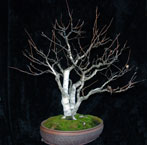Quiet Crow Bonsai
A Collection of Stellar Bonsai MusingsProject
White Bark Birch
Betula papyrifera Paper birch is best grown in medium to wet, well-drained sandy or rocky loams in part shade. It is best when it receives some afternoon shade. It needs consistently moist soils keep the root zones cool and moist. It needs little pruning, but if necessary, prune during the dormant season. Avoid pruning in spring when the sap is running. Performs best in cool northern climates where summer temperatures rarely exceed 75 degrees F. and where root zones are generally covered with snow throughout the winter.
This tree was collected in upper Michigan in an overgrown golf course. In 1995, we put a tourniquet around taproot to force development of roots above it. In 1997 it was repotted into this new Sara Raynor show pot. At that time I still left the tourniquet around the root. Later that year it was judged by Ivan Water at our annual exhibit these were his comments "Nice composition. Tree is healthy even though as a rule birches do not do well as bonsai. The pot is the right size based on the tree’s needs generally it would be considered large. Next potting move the big trunk forward in the pot so they are not parallel. Wire apex forward on both of larger trunks. Tighten silhouette." So that is what I set out to do.
By 2000 I had decided to take the styling a different direction. I wired every branch trying to make it a weeping birch. While this looked good when wired, it was not what the tree in nature would expect to do. It was about a month into its new design that the health started to decline. As if that were not enough when I removed the wire the branches did not hold.
During the repotting of 2002, I struggled to get it out of the pot, had to remove many circular roots and decided at that time that this tree needs to be repotted every year. I had not found the wire tourniquet around taproot but was not concerned. Two years later I made another mistake with this tree by leaving the wire on too long which scarred a major branch. Additionally the apex started showing signs of decline, and Ted Matson suggested keeping the crown open to allow sun in.
Taking this tree to a workshop with Ted in March of 2006, we began to prune the structure of the tree. Until this time I was pretty diligent about removing the terminal buds to develop twigging. But the health was still in decline, I started to loose 10% of any twigging I had developed. Ted suggested we look closely at the roots to see if anything is wrong (and maybe find the tourniquet). With his help I removed almost all of the old soil and roots, this exposed a bottom coil of roots that had fused together. Ted said there was not much we could do about this old coil but as long as roots keep regenerating I should not have any trouble. I should however continue to repot every year but allow the terminal budes to extend.
March of 2007 the tree was still in decline. I was still loosing 10% of twigs and lost the apex. I had to saw below the apex where I could find healthy tissue used cut paste to to help healing and prevent sap loss. I used guy wires to position a branch up and center to be the new apex. By early spring 2008 the tree started to recover, buds look healthy no loss of branches. I continued to work on regenerating the roots by removing more of the coiled roots.
By 2009 the roots were definitely better. I started using soil additives (see articles) and began to trim back and remove terminal buds in Spring. The tree started to really turn around in the following years. I continued to develop new apex, pulling it forward and center. And in August of 2012 it took first place and award of merit at the State Fair show. Houstons comments included "Difficult tree to score in conventional sense. Love the bark and size of base, lots of character, comments are based on classical bonsai. Could the apex come toward viewer, could use secondary branching in several places. I like the bonsai overall, incredible job on difficult species"
In June of 2013 at a Suthin workshop at my house with Houston and Steve, we all reviewed and each of us were to pick a front. We all picked the same front. So now the youngest tree in the clump is the first branch (as is the standard). Styled the new apex and trimmed. Wired only some of the first branch. Suthin thought the pot was fine. Next repot (2014) ensure tree is placed with the new front. Check back for a picture.




